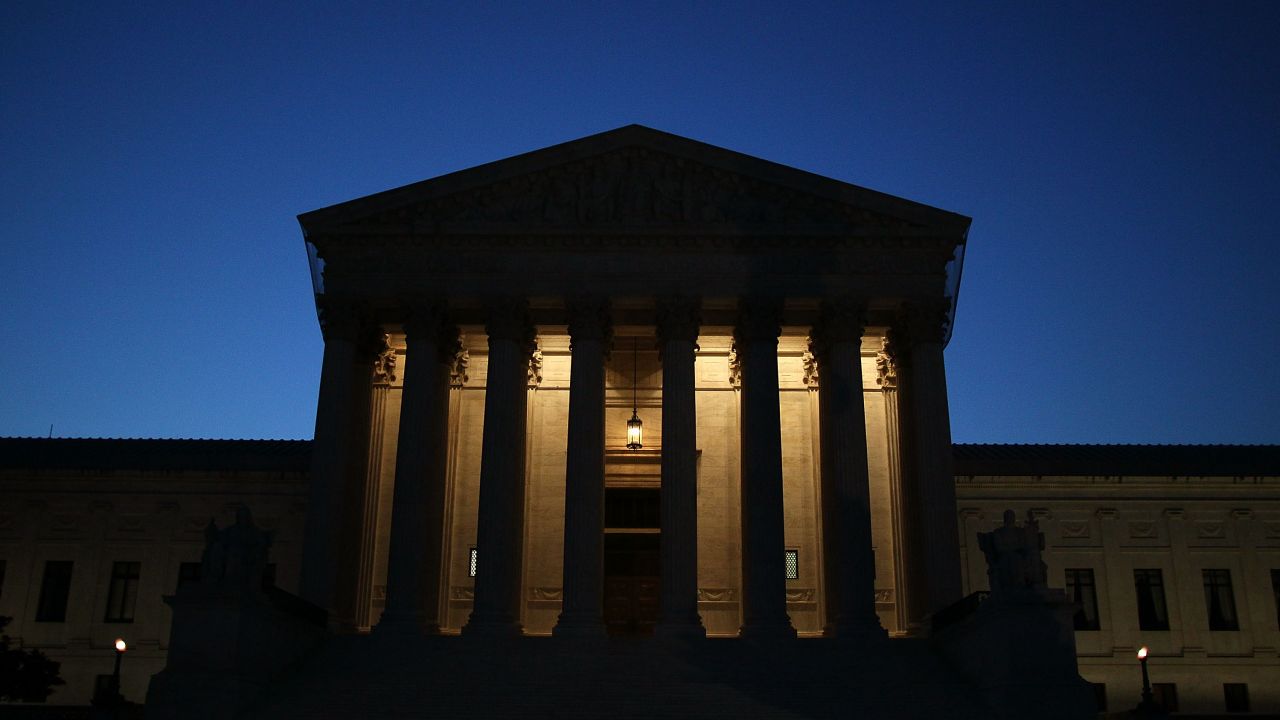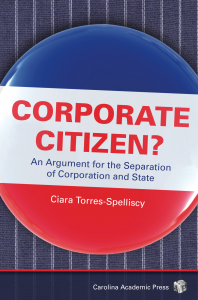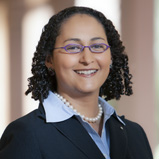
More and more, corporations have been successful in convincing the courts that they should have the same constitutional rights as human beings. (Photo by Mark Wilson/Getty Images)
This is an excerpt from the newly published book Corporate Citizen? An Argument for the Separation of Corporation and State, by law professor and Brennan Center fellow Ciara Torres-Spelliscy. Read more about the author here and listen to the audio of our full interview here. This excerpt has been lightly edited for length.
Citizens United v. FEC gave corporations the ability to influence the political process more directly, which has in turn made elected officials more responsive to moneyed interests, and therefore as a matter of logic, less responsive to less-wealthy citizens.
—Chief Justice of Delaware Supreme Court Leo Strine1
The year 2010 was an inflection point for the role of corporations in our democracy. Biologist Stephen Jay Gould, who taught at Harvard, had a theory of evolution called “punctuated equilibrium.”2 According to Professor Gould, evolution isn’t always a slow and gradual process. Rather, evolution can take huge, fast, punctuated leaps forward. Citizens United v. Federal Election Commission was such a punctuated moment in the evolution of corporate citizenship.
…
Citizens United shifted the landscape, but it wasn’t the only thing going on in the evolution of corporate citizenship in 2010…Congress issued two landmark pieces of legislation in 2010, both of which propelled litigation that had a profound impact on how the courts conceptualized the relationship among corporations, individuals and the state. The first piece of legislation was the Dodd-Frank Wall Street Reform and Consumer Protection Act (or just Dodd-Frank for short).4… The second piece of legislation was the Patient Protection and Affordable Care Act (also known as ACA), which expanded access to health insurance for millions of Americans, and required employers to provide coverage, which included birth control for women.5
…
While these laws imposed new responsibilities on corporations, corporate lawyers would spend the next five years trying to resist and punch holes in these laws. Both laws would be weakened by lobbying in the administrative rulemaking process, and through targeted litigation by trade associations.7 Parts of the ACA were challenged as being beyond Congress’ Commerce Clause and Spending Powers.8 Some of Dodd-Frank’s rules were challenged as violating the First Amendment.9
Back in the courtroom in 2010, human rights lawyers were busy trying to enforce claims against Royal Dutch Petroleum (better known as Shell) for its alleged participation in the execution of environmental activists in Nigeria. The US Court of Appeals for the 2nd Circuit, in a case called Kiobel, rejected the claim, holding that Shell could not be sued for these alleged human rights abuses in the American federal courts.10 This case would be appealed to the Supreme Court where it — like Citizens United — would be argued twice.11 The court would side with Shell, albeit on different grounds of extraterritoriality, thereby closing the federal courthouse door against these and potentially future human rights victims who were harmed by multinational corporations abroad.
Meanwhile, as the courts debated the legal rights and responsibilities of corporations, a different conversation was occurring in state capitals throughout the country about the purpose of corporations and the positive role they could play in American society. Many negative effects of business corporations are traceable to their requirement to focus relentlessly on making profits. But at the prodding of innovative entrepreneurs, state lawmakers finally asked the question: What if corporations had a broader mission that took account of societal needs? In 2010, Maryland became the first state in America to allow for a new form of incorporation called benefit corporations.12 Since then, 30 other states, including Delaware, a state that contains more corporations than human beings, have adopted benefit corporation laws. This structure allows benefit corporations (also colloquially known as “B corps”) to build social values into their foundational corporate documents (including articles of incorporation and by-laws), instead of merely being focused on profit maximization.13
Near the end of this momentous year, the midterm congressional election also took place. The impact of Citizens United was immediately clear. Roughly $450 million in outside money was spent in this federal election,14 and $131 million of that spending was from dark-money sources.15 “Dark money” means political spending where the original source is impossible for the public to discover. As Federal Election Commission (FEC) Chair Ann Ravel noted, “[t]here are circuitous ways to spend. We have the nesting doll problem with dark money.”16 Because much of that dark money was funneled through trade associations like the US Chamber of Commerce, there is a deep suspicion that much of this dark money came from corporations exercising their new Citizens United rights to spend.17 But because the money is dark, the public may never know for sure. As prominent political lawyer Trevor Potter explained, “[W]e only know corporate funding of most political ads when it is inadvertently disclosed.”18
Corporate political spending, to the extent it is uncovered, is revealed piecemeal and haphazardly.19 On occasion, the truth about the corporate source of dark money comes out because of litigation. For example, after two dark-money groups hid the source of spending for two California ballot initiatives in 2012 and were sued, they settled with California for a $1 million fine and disclosed where the money came from.20 A similar story happened in Montana when a judge ordered a dark-money group called Western Tradition Partnership (which later changed its name to American Tradition Partnership) to release its bank records.21 Among the documents in that case was “a PowerPoint presentation, in which the leader of Western Tradition was telling donors that they could anonymously donate huge sums to influence the election results in Montana, and that no one would know that they had given the money that had won the candidate his or her seat in office. The anonymous donors could sit back on Election Day and watch results roll in and no one would know. No one in the public would know that they had basically distorted that election.”22
(Excerpted with permission from Carolina Academic Press. Copyright (c) 2016 by Ciara Torres-Spelliscy. All rights reserved.)
1. Leo E. Strine, Jr., Corporate Power Ratchet: The Courts’ Role in Eroding “We the People’s” Ability to Constrain Our Corporate Creations, 51 Harv. Civil Rights-Civil Liber- ties L. Rev. (Forthcoming 2016) (manuscript at 15). ↩
2. Stephen Jay Gould, Punctuated Equilibrium (2007). ↩
4. Dodd-Frank Wall Street Reform & Consumer Protection Act (Pub. L. 111–203, H.R. 4173). ↩
5. The Patient Protection & Affordable Care Act (Pub. L. 111–148, H.R. 3590). ↩
7. Patrick Caldwell, Did You Know That Antonin Scalia’s Son Is Sabotaging Wall Street Reform?, Mother Jones (July/August 2014); Jennifer Taub, Other People’s Houses 291 (2014) (“since Dodd-Frank was enacted in 2010, the financial services lobby devoted considerable resources to delay implementation of the strongest parts …”). ↩
8. National Federation of Independent Business v. Sibelius, 132 S. Ct. 2566 (2012) (upholding the individual mandate); King v. Burwell, 576 U.S. _ (2015) (upholding fed- eral health care exchanges). ↩
9. Nat’l Ass’n of Mfrs. v. S.E.C., 748 F.3d 359, 363 (D.C. Cir. 2014) adhered to on reh’g sub nom. Nat’l Ass’n of Mfrs. v. S.E.C., 800 F.3d 518 (D.C. Cir. 2015) overruled by Am. Meat Inst. v. U.S. Dep’t of Agric., 760 F.3d 18 (D.C. Cir. 2014); Am. Petroleum Inst. v. S.E.C., 953 F. Supp. 2d 5, 11 (D.D.C. 2013) (“Plaintiffs argue that section 13(q) and the Rule com- pel speech in violation of the First Amendment. . . . The Court will not reach plaintiffs’ First Amendment challenge …”); Consumer Fin. Prot. Bureau v. ITT Educ. Servs., Inc., No. 1:14-CV-00292-SEB, 2015 WL 1013508, at *16 (S.D. Ind. Mar. 6, 2015) (“ITT urges that . . . the regulation of its communications to its students chills its First Amendment speech rights …”). ↩
10. Joel Slawotsky, ATS Liability for Rogue Banking in a Post-Kiobel World, 37 Hastings Int’l & Comp. L. Rev. 121, 132–136 (2014). ↩
11. Kiobel v. Royal Dutch Petroleum, 133 S. Ct. 1659 (2013) (Argued Feb. 28, 2012 — Reargued Oct. 1, 2012).]↩
12. Maryland S.B. 690 (2010), http://mlis.state.md.us/2010rs/chapters_noln/Ch_97_ sb0690T.pdf. ↩
13. Benefit Corp. Info. Ctr., State by State Legislative Status (2015), (listing 30 states plus D.C. with benefit corporation laws). ↩
14. Paul Blumenthal, The Citizens United Effect: 40 Percent of Outside Money Made Possible by Supreme Court Ruling, Sunlight Foundation (Nov. 4, 2010). ↩
15. Robert Maguire, How 2014 Is Shaping Up to Be the Darkest Money Election to Date, Ctr. for Responsive Politics (Apr. 30, 2014). ↩
16. Interview with Ann Ravel, Chair, Federal Election Commission (Nov. 3, 2015). ↩
17. Interview with Frederick A.O. Schwarz, Chief Counsel Brennan Center for Justice at NYU School of Law (July 21, 2015) (“After Citizens United, investors don’t know if companies are spending in politics.”). ↩
18. Interview with Trevor Potter, President Campaign Legal Ctr. (July 27, 2015). ↩
19. Ciara Torres-Spelliscy, Courts Shine Light on Dark Money, Brennan Ctr. Blog (May 26, 2015). ↩
20. Kim Barker, Dark Money Groups Pay $1 Million in Fines in California Case, Pro Publica (Oct. 24, 2013), (“the Center to Protect Patient Rights conceded it was responsible for funneling $11 million through Americans for Responsible Leadership to a political committee … The Center to Protect Patient Rights also gave an additional $4 million to another dark money group, the American Future Fund …”). ↩
21. Kim Barker, Rick Young & Emma Schwartz, Dark Money Group’s Donors Revealed, Frontline (Nov. 5, 2012, 10:18 am ET), (“The WTP bank records … show that the group raised almost $1.1 million from other social welfare nonprofits, corporations, a political committee and individuals. It received $650,000 from the nonprofits, $70,000 from an Oklahoma businessman and his company and $50,000 from a Colorado homebuilder.”). ↩
22. Interview with Lisa Graves,Executive Director Center for Media & Democracy (July 17, 2015). ↩





